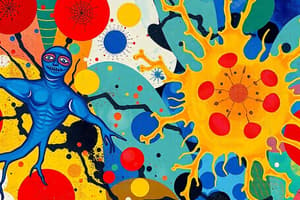Podcast
Questions and Answers
What is a characteristic of Proteus bacteria?
What is a characteristic of Proteus bacteria?
- They are non-motile and lactose fermenting
- They are highly motile and lactose fermenting
- They are Gram-negative and aerobic (correct)
- They are Gram-positive and anaerobic
What is Pseudomonas aeruginosa frequently reported in, besides hospital infections?
What is Pseudomonas aeruginosa frequently reported in, besides hospital infections?
- Mastitis in dairy cattle and pneumonia in red deer
- Urinary tract and ear infections in human
- Cystic fibrosis in human
- All of the above (correct)
What is the purpose of adding chloralhydrate or potassium tellurite to the medium?
What is the purpose of adding chloralhydrate or potassium tellurite to the medium?
- To enhance the growth of Proteus bacteria
- To accelerate the fermentation of lactose
- To inhibit the spreading of Proteus bacteria over the agar surface (correct)
- To inhibit the growth of other bacteria
What is the characteristic of Pseudomonas aeruginosa colonies on blood agar?
What is the characteristic of Pseudomonas aeruginosa colonies on blood agar?
What is the color of Proteus colonies on MacConkey agar?
What is the color of Proteus colonies on MacConkey agar?
What is the optimal temperature for the growth of Pseudomonas aeruginosa?
What is the optimal temperature for the growth of Pseudomonas aeruginosa?
What is the reaction of Proteus bacteria on KIA media?
What is the reaction of Proteus bacteria on KIA media?
What is the result of the O-F test for Pseudomonas aeruginosa?
What is the result of the O-F test for Pseudomonas aeruginosa?
What is the habitat of Proteus species?
What is the habitat of Proteus species?
What is the characteristic of Pseudomonas aeruginosa in terms of urea and indole?
What is the characteristic of Pseudomonas aeruginosa in terms of urea and indole?
What is the disease caused by Proteus bacteria in dogs and horses?
What is the disease caused by Proteus bacteria in dogs and horses?
What is the purpose of covering the surface of one O-F tube with paraffin oil?
What is the purpose of covering the surface of one O-F tube with paraffin oil?
What is the morphology of Pseudomonas aeruginosa on Gram's stain?
What is the morphology of Pseudomonas aeruginosa on Gram's stain?
What is the purpose of inoculating IMViC and KIA media?
What is the purpose of inoculating IMViC and KIA media?
What is a characteristic of Pseudomonas aeruginosa?
What is a characteristic of Pseudomonas aeruginosa?
What media is used to differentiate Pseudomonas aeruginosa from Enterobacteriaceae?
What media is used to differentiate Pseudomonas aeruginosa from Enterobacteriaceae?
Flashcards are hidden until you start studying
Study Notes
Proteus
- Proteus bacteria are Gram-negative, aerobic, and highly motile, with a characteristic ammonia smell.
- They tend to swarm, spreading rapidly over the surface of solid media, making it difficult to isolate other bacteria.
- Adding chloralhydrate or potassium tellurite to the medium can inhibit the spreading of growth.
- Proteus does not ferment lactose, rapidly liquefy gelatin, produce H2S, and decompose urea.
- On MacConkey agar, colonies appear pale in color, on brilliant green agar and XLD media, red colonies appear.
- Colonies are 2-3 mm in diameter, non-hemolytic, shiny, round, and grayish in color.
- On KIA, Proteus vulgaris gives A/A + H2S, and Salmonella and P.mirabilis give K/A + H2S.
- Proteus species are free-living in water, soil, and sewage, and can cause diseases in the urogenital and gastrointestinal tracts of humans.
Pseudomonas Aeruginosa
- Pseudomonas aeruginosa is an important potential pathogen, causing infections in various animal species and humans.
- It has been reported to infect wounds, giving rise to blue-green pus, and causing mastitis in dairy cattle, pneumonia in red deer, and green wool infection in sheep.
- It is also reported in cases of cystic fibrosis in humans and urinary tract and ear infections.
- However, the organism is a frequent contaminant, and its isolation is not necessarily clinically significant.
- It is an important hospital-acquired pathogen, causing nosocomial infections.
- Pseudomonas aeruginosa grows well on selective agar media used for Enterobacteriaceae, with colony morphology similar to those of enteric bacteria.
- However, unlike Enterobacteriaceae, Pseudomonas are oxidase positive.
- On blood agar, most Pseudomonas species form large, flat, spreading gray colonies with irregular margins.
- Some cultures are mucoid, while others are beta-hemolytic, and most have a fruit-like or sweet ammonia odor.
- Pseudomonas aeruginosa is slow-growing at 4°C but grows at 42°C.
- It oxidizes glucose but not other sugars, liquefies gelatin, hydrolyzes arginine, and is H2S negative, urea positive, indole negative, oxidase and catalase positive.
- In the O-F test, it oxidizes glucose in the aerobic tube, turning the color from green to yellow.
Studying That Suits You
Use AI to generate personalized quizzes and flashcards to suit your learning preferences.



